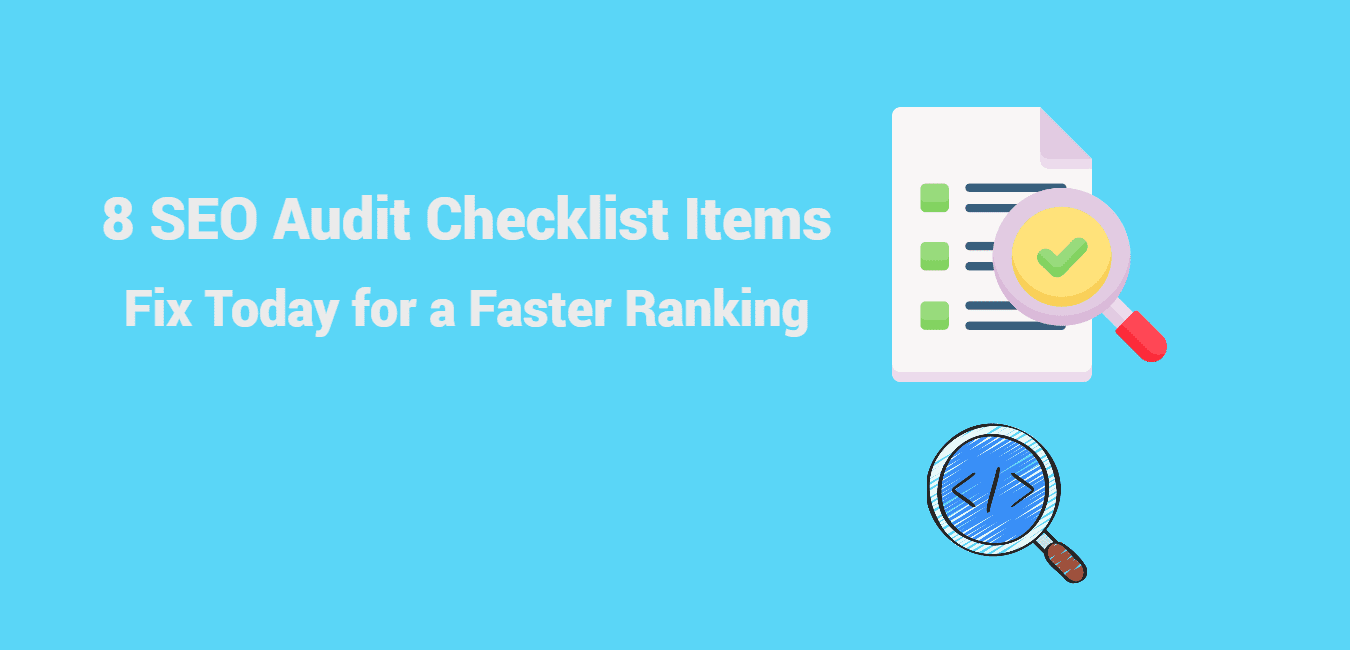
8 SEO Audit Checklist Items to Fix Today for a Faster Ranking
Are you looking to get your website ranked quickly? If so, an SEO audit checklist is a great place to start. An SEO audit is an essential step in any website optimization process, as it helps to identify areas where improvements can be made to maximize your website’s visibility in search engine results. By using this checklist, you can quickly find and fix any issues that could be preventing your website from ranking higher. Read on to learn more about the eight SEO audit checklist items that you should address today to get your website on the fast track to a better ranking.
1)Fix Your Crawlability Errors
One of the most important parts of an SEO Audit Checklist is making sure that all of your webpages can be found and crawled by search engines. Crawlability errors can prevent pages from being indexed, leading to a decrease in your ranking and preventing potential customers from finding you. To get ranked fast, make sure to fix any crawlability errors you find during your audit.
Start by verifying that all of your website’s pages are listed in the XML sitemap, which is a roadmap for search engine crawlers. If any of your pages aren’t listed, make sure to add them in. You should also check for any broken links within the sitemap and fix them. This will help search engines find all of the pages on your site and ensure they are properly indexed.
Another important part of your crawlability audit should be to look for any orphaned or dead pages on your website. This means pages that are not linked to any other page and are not included in the sitemap. These types of pages are hard to find and crawl by search engine crawlers, so they should be removed.
Finally, you should also verify that there are no technical issues such as server errors or blocked resources that could prevent search engine crawlers from crawling your site. Make sure to check all server error logs to identify any technical issues and fix them as soon as possible.
Fixing these crawlability errors during your SEO Audit Checklist is essential to ensure your website is easily found and indexed by search engines. This will help you get ranked fast and bring in more customers.
2) Improve Your Page Speed
One of the most important SEO audit checklist items you need to address is page speed. If your website is slow, it can negatively affect your search engine rankings and user experience. To get ranked fast, you must optimize your page speed and ensure that pages load quickly and reliably.
You can improve page speed in a variety of ways. For example, you can reduce the size of your images by compressing them, or use a content delivery network (CDN) to serve your content from multiple locations around the world. Additionally, you can use caching to store data locally and enable Gzip compression for improved loading times. Finally, you should look into updating your web hosting provider to ensure that your site is running on the most recent server technology.
By following these tips and completing the other items on the SEO audit checklist, you will be well on your way to improving your website’s performance and getting ranked fast.

3) Optimize Your Title Tags
One of the most important steps in your SEO Audit Checklist is optimizing your title tags. Title tags are the text that appears at the top of a web page, and they are often used by search engines to determine the content of a page. By optimizing your title tags, you can help search engines to understand what your page is about and increase your chances of getting ranked fast.
When it comes to optimizing your title tags, there are a few key factors to consider. First, make sure that the title tag accurately reflects the content of your page. It should be clear and concise and contain relevant keywords. Keep it under 60 characters so it’s easy to read in the search results. Also, ensure that you include a call-to-action phrase such as “Learn More” or “Shop Now”.
By following these simple steps, you can ensure that your title tags are optimized for search engines and improve your chances of getting ranked fast. So, be sure to include optimizing your title tags on your SEO Audit Checklist!
4) Optimize Your Meta Descriptions
Meta descriptions are an important part of any SEO audit checklist, as they can help your website get ranked fast. Meta descriptions are the short summaries of your webpages that appear in the search engine results pages (SERPs). A good meta description should be between 150 and 160 characters, contain relevant keywords, and accurately describe the content of the page. To optimize your meta descriptions, you should:
• Create unique meta descriptions for each page – Duplicate meta descriptions will not help your website get ranked fast and may even hurt your ranking.
• Include relevant keywords – Choose the keywords that are most closely related to the page’s content and include them in the meta description.
• Make it enticing – The meta description should entice people to click on your page, so make sure it is concise and compelling.
By taking the time to optimize your meta descriptions, you can ensure that your website will get ranked fast in the SERPs.
5) Optimize Your H1 Tags
The H1 tag is a key element of your website and should be optimized as part of your SEO audit checklist. It helps search engine crawlers to better understand the purpose of your web page and is essential for getting ranked fast. The H1 tag should be the most important headline on the page, clearly identifying what it is about. For example, if the page is about “How to Train a Dog”, the H1 tag should read “How to Train a Dog”.
Make sure that each page has only one H1 tag and that the H1 tag reflects the content of the page. Also, keep it short and sweet – no more than 60 characters – as search engines will display only the first 60 characters in their results. Finally, include keywords that are relevant to the topic of your page in the H1 tag. This will help your web page appear higher in search engine results when people are searching for those keywords. By optimizing your H1 tags, you can increase your chances of getting ranked fast.
6) Optimize Your Images
Having properly optimized images is an important part of a successful SEO Audit Checklist. Images can help boost your page rankings and help you get ranked faster. When it comes to optimizing your images, there are a few key things to consider:
1) File Size: Make sure the size of your images are as small as possible while still maintaining their quality. This will ensure that they load quickly and won’t bog down the page speed.
2) File Names: Make sure your image file names include relevant keywords so that search engines can better index them.
3) Alt Text: This is text used to describe an image when it doesn’t load or can’t be seen. This is another way that search engines understand the content of an image, so make sure to use relevant keywords.
By taking these steps to optimize your images, you’ll be able to improve your SEO audit checklist and get ranked faster.
7) Implement Schema Markup
One of the key items in any SEO audit checklist should be to implement schema markup. This involves adding structured data to your website that can help search engines better understand the content of your pages. This helps them to index and rank your website more effectively, and ultimately helps you get ranked faster.
Schema markup can be added to almost any HTML element on a page, and it’s recommended to include it on every page on your website. The most popular types of schema markup include reviews, people, products, and organizations. You can find a full list of supported schemas here.
Once you have chosen which schemas to include on your website, you need to use the Structured Data Markup Helper from Google. This tool will help you add the required HTML tags, so that you can quickly get started with implementing your schema markup.
Including schema markup on your website is one of the most important items on your SEO audit checklist. Implementing this step correctly and consistently across all pages can help you to improve your website rankings and get ranked faster in the search engine results pages.
8) Monitor Your Backlinks
The last item on your SEO audit checklist should be to monitor your backlinks. Backlinks are one of the most important ranking factors and having too many from low-quality sources can hurt your rankings. Keeping track of who’s linking to you and what type of content they are linking to will help you identify any issues that need to be addressed.
Using a backlink monitoring tool like Ahrefs or SEMRush can help you review the links pointing to your website. Check each link to see if it’s from a reputable source, and take action if any seem suspicious or untrustworthy. Additionally, look for opportunities to add more high-quality links. Having quality backlinks is key to getting ranked fast, so make sure you’re doing all you can to maximize them.
By taking the time to review your backlinks, you can improve your SEO audit score and get on the path to getting ranked fast. Use a monitoring tool to stay on top of any changes and make sure your backlink profile is healthy. Don’t forget about this crucial piece of your SEO audit checklist!




